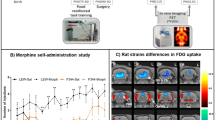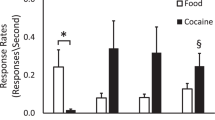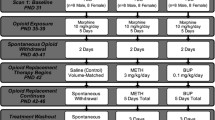Abstract
Quantitative autoradiography of [14C]deoxyglucose, [14C]iodoantipyrine, and [14C]leucine was used to estimate regional cerebral glucose metabolism, cerebral blood flow, and cerebral protein synthesis, respectively, in rats during morphine dependence and withdrawal. Glucose metabolism was elevated in 19 of 26 selected brain regions; the elevations in glucose metabolism were similar when data were expressed as either optical density ratios or as calculated rate values of μmol/100 gm/min. Restraining the rats produced heterogeneous effects on glucose metabolism during morphine withdrawal (MW). Neither estimated cerebral blood flow nor cerebral protein synthesis were affected by morphine and/or naloxone treatments in either naive or morphine-dependent rats. The data demonstrate that changes in regional cerebral glucose utilization occur independently of blood flow changes and exclude the possibility that regional changes in glucose utilization occur as a consequence of large regional changes in protein synthesis rates in brain. These data confirm the utility of 2-deoxyglucose measures of MW as objective biochemical indices of opiate agonist and antagonist effects in vivo.
Similar content being viewed by others
References
Way, E. L., Loh, H. H., and Shen, F. H., 1969. Simultaneous quantitative assessment of morphine tolerance and physical dependence. J. Pharmacol. Exp. Ther. 167:1–8.
Wei, E., Loh, H. H., and Way, E. L., 1972. Quantitative aspects of precipitated abstinence in morphine-dependent rats. J. Pharmacol. Exp. Ther. 184:398–403.
Blasig, J., Herz, A., Reinhold, K., and Zieglgansberger, S., 1973. Development of physical dependence on morphine in respect to time and dosage and quantification of the precipitated withdrawal syndrome in rats. Psychopharm. (Berlin) 33:19–38.
Wei, E., Sigel, S., and Way, E. L. 1975. Regional sensitivity of the rat brain to the inhibitory effects of morphine on wet shake behavior. J. Pharmacol. Exp. Ther. 193:56–63.
Calvino, B., Lagowska, J., and Ben-Ari, Y., 1979. Morphine withdrawal syndrome: differential participation of structures located within the amygdaloid complex and striatum of the rat. Brain Res. 177:19–34.
Tremblay, E. C., and Charton, G., 1981. Anatomical correlates of the morphine withdrawal syndrome: differential participation of structures located within the limbic system and striatum. Neurosci. Lett. 23:137–142.
Aghajanian, G. K., 1978. Tolerance of locus coeruleus neurones to merphine and suppression of withdrawal response by clonidine. Nature 276:186–187.
Dafny, N., 1982. The hypothalamus exhibits electrophysiologic evidence for morphine tolerance and dependence. Exp. Neurol. 77:66–77.
Wooten, G. F., DiStefano, P., and Collins, R. C., 1982. Regional cerebral glucose utilization during morphine withdrawal in the rat. Proc. Nat. Acad. Sci. USA 79:3360–3364.
Geary, W. A., and Wooten, G. F., 1983. A behavioral and 2-deoxyglucose autoradiographic study of the effects of cumulative morphine dose on naloxone precipitated withdrawal in the rat. Brain Res. 275:117–126.
Geary, W. A., and Wooten, G. F., 1985. Dose effects of naloxone on fixed morphine dependence: simultaneous behavioral and 2-deoxyglucose study in the rat. Brain Res. 332:69–78.
Geary, W. A., and Wooten, G. F., 1985. Similar functional anatomy of spontaneous and precipitated morphine withdrawal. Brain Res. 334:183–186.
Geary, W. A., and Wooten, G. F., 1986. Time-action profiles of regional cerebral glucose utilization during naloxone precipitated morphine withdrawal. Brain Res. 399:181–184.
Sokoloff, L., Reivich, M., Kennedy, C., DesRosiers, M. H., Patlak, C. S., Pettigrew, K. D., Sakurada, O., and Shinohara, M., 1977. The [14C]deoxyglucose method for the measurement of local cerebral glucose utilization: theory, procedure, and normal values in the conscious and anesthetized albino rat. J. Neurochem. 28:897–916.
Cicero, T. J., Meyer, E. R., Bell, R. D., and Koch, G. A., 1976. Effects of morphine and methadone on serum testosterone and leuteinizing hormone levels and on the secondary sex organs of the male rat. Endocrinology 98:367–372.
Lowry, O. H., and Passoneau, J. V., 1972. Page 174, A Flexible System of Enzymatic Analysis, Academic Press, New York.
Sharp, F. R., Kilduff, T. S., Bzorgchami, S., Heller, H. C., and Ryan, A. F., 1983. The relationship of local cerebral glucose utilization to optical density ratios. Brain Res. 263:97–103.
Mitchell, I. J., and Crossman, A. R., 1984. In defense of optical density ratios in 2-deoxyglucose autoradiography. Brain Res. 298:191–192.
Reivich, M., Jehle, J., Sokoloff, L., and Ketz, S. S., 1969. Measurement of regional cerebral blood flow with antipyrine-14C in awake rats. J. Appl. Physiol. 27:296–300.
Dwyer, B. E., Donatoni, P., and Wasterlain, C. G., 1982. A quantitative autoradiographic method for the measurement of local rates of brain protein synthesis. Neurochem. Res. 7:563–576.
Kennedy, C., Suda, S., Smith, C. B., Miyaoka, M., Ito, M., and Sokoloff, L., 1981. Changes in protein synthesis underlying functional plasticity in immature monkey visual system. Proc. Nat. Acad. Sci. USA 78:3950–3953.
Collins, R. C., and Nandi, N., 1982. Focal seizures disrupt protein synthesis in seizure pathways: an autoradiographic study using [1-14C]leucine. Brain Res. 248:109–119.
Dunlop, D. S., van Elden, W., and Lajtha, A., 1975. A method for measuring brain protein synthesis rates in young and adult rats. J. Neurochem. 24:337–344.
Dienel, G. A., Pulsinelli, W. A., and Duffy, T. E., 1980. Regional protein synthesis in rat brain following acute hemispheric ischemia. J. Neurochem. 35:1216–1226.
Snedecor, G. W., and Cochran, W. G. 1967. Statistical Methods. Iowa State University Press, Ames, Iowa.
Hawkins, R. A., Hass, W. K., and Ransohoff, J., 1979. Measurement of regional brain glucose utilization in vivo using [2-14C]glucose. Stroke 10:690–703.
Bryan, R. M., Hawkins, R. A., Mans, A. M., Davis, D. W., and Page, R. B., 1983. Cerebral glucose utilization in awake unstressed rats. Am. J. Physiol. 244(Cell Physiol. 13):C270-C275.
Hawkins, R. A., Mans, A. M., Davis, D. W., Hibbard, L. S., and Lu, D. M., 1983. Glucose availability to individual cerebral structures is correlated to glucose metabolism. J. Neurochem. 40:1013–1018.
Geary, W. A., and Wooten, G. F., 1986. Correspondence of regional fractional occupancy of opiate receptors in vivo and the biological effects of naloxone in precipitated morphine withdrawal. Submitted June, 1986.
Kagan, S., Ferguson, R. K., and Mitchell, C. L., 1973. An investigation of pharmacologic and behavioral tolerance to morphine in rats. J. Pharmacol. Exp. Ther. 185:300–306.
Siegel, S., Hinson, R. E., and Krank, M. D., 1981. Morphineinduced attenuation of morphine tolerance. Science 212:1533–1534.
Wei, E., Tseng, L. F., Loh, H., and Way, E. L., 1974. Similarity of morphine abstinence signs to thermoregulatory behavior. Nature 247:398–400.
Ohata, M., Takei, H., Fredericks, W. R., and Rapaport, S. I., 1982. Effects of immobilization stress on cerebral blood flow and cerebrovascular permeability in spontaneously hypertensive rats. J. Cereb. Blood Flow and Metab. 2:373–379.
Cox, B. M., and Osman, O. H., 1970. Inhibition of the development of tolerance to morphine in rats by drugs which inhibit ribonucleic acid or protein synthesis. Br. J. Pharmacol. 38:157–170.
Hahn, D. L., and Goldstein, A., 1971. Amounts and turnover rates of brain proteins in morphine tolerant mice. J. Neurochem. 18:1887–1893.
Feinberg, M. P., and Cochin, J., 1972. Inhibition of development of tolerance to morphine by cycloheximide. Biochem. Pharmacol. 21:3082–3085.
Clouet, D. H., and Iwatsubo, K., 1975. Mechanisms of tolerance to and dependence on narcotic analgesic drugs. Annu. Rev. Pharmacol. Toxicol. 15:49–71.
Castles, T. R., Campbell, S., Gouge, R., and Lee, C. C., 1972. Nucleic acid synthesis in brains from rats tolerant to morphine analgesia. J. Pharmacol. Ex. Ther. 181:399–406.
Author information
Authors and Affiliations
Rights and permissions
About this article
Cite this article
Geary, W.A., Wooten, G.F. In vivo tracer studies of glucose metabolism, cerebral blood flow, and protein synthesis in naloxone precipitated morphine withdrawal. Neurochem Res 12, 573–580 (1987). https://doi.org/10.1007/BF00971004
Accepted:
Issue Date:
DOI: https://doi.org/10.1007/BF00971004




